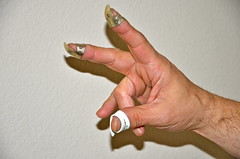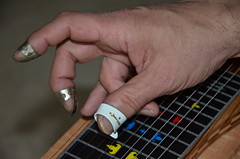Attack
One of the tendencies when you first start playing is to attack the strings to hard. I guess for me it was a way I tried to compensate for not getting sustain. In fact, attacking the strings too hard does the opposite and does not give you the tone you are looking for. Be kind to your strings and less attack. Let the natural tone of the guitar work for you.
Palm Blocking
One of the first techniques I learned was palm blocking. Were going to use strings 4-5-6 on the E9 neck. keep your right edge of your picking hand on the pickups. Place your thumb pick against the 6th string, first finger pick against the 5th string and your middle finger against the 4th string. Now pick the 6th string and then block the string using the right edge of your picking hand and block the string. Pick the 5th string and block. Pick the 4th string and block. Do this slowly as this is not a race but you are training the muscle memory of your fingers. Speed will come in time. Spend about 5 to 10 minutes a day practicing this. Any more and you will die from boredom.
Finger Blocking
Finger blocking is when you pick a string and then place your picking finger against the string to block the tone. It has a different sound than palm blocking. Move back and forth between palm blocking and finger blocking.Hammer On/Off
Hammer On and Hammer Off are easy techniques to learn. With your first finger pick the open 4th string. As the string rings out place the tone bar on the 2nd fret. Hammer off is the opposite maneuver. With the bar on the 2nd fret, pick the 4th string and as the string rings remove the bar from the 2nd fret. You have just learned what you need for Steel Guitar Rag!Roll
A roll sounds like a strum. Using strings 4-5-6 where thumb on 6th string, first finger on 5th string, and middle finger on the 4th string. Now pick 6, 5, and 4 in that order letting each string ring out. It should sound like a strum with even intervals between the picking of each string.Raking
There is both forward raking and backward raking. Forward raking is strumming the strings from 10th string to the first string. Now you do not need to start with the 10th string. You could start from any string and stop at any string. I have raked from the 8th string to the 2nd string. In this instance I add the safety of putting my ring finger against the 1st string to prevent me from accidentally striking the first string. The reverse rake is exactly the opposite of the forward rake. While I have not used the reverse rake, I have seen my instructor use it.Finger Harmonics
Some people find harmonics easy and others find it difficult. I have a more difficult time with palm harmonics than I do with finger harmonics. This is a re-post from My Journey Part I.
1. Place your tone bar on a fret. For our purposes lets use the 3rd fret.
2. Now you get to hold your picking hand in a weird contorted position. With your picking hand in front of you, hold your thumb in the 9 o'clock position with your forearm at a 30 degree (approximately) to your body. Your ring finger will be at the 9 o'clock position. Your middle finger will be pointing straight back at your body. The proper position will have the middle finger parallel the fret markers.
3. With tone bar at the 3rd fret, we need to pick one octave up at the 15th fret. Pick the 4th string with thumb and middle finger at the same time. The image below shows me at the 17th fret.
Do not be surprised if you get a "thunk" sound the first few times you do this. What you will need to do is ensure your tone bar is properly placed. Just because you are exactly on the 3rd fret does not ensure a harmonic. If you are tuned slightly flat or sharp you will need to adjust your placement of the tone bar. Also, in conjunction with tone bar placement, you may pick slightly flat or sharp around the 15th fret to find the "sweet spot" of your guitar. Some guitars are more forgiving than others.
Tip:
After you get the basic technique down for harmonics, here is an exercise that helped me. Place your tone bar at the 5th fret. Pick your harmonics at the 15th fret, picking all ten strings. I start at the 10th string and work my way up to the 1st string and then back down. Now, leaving your tone bar at the 5th fret, move down to the 12th fret and pick the harmonic there repeating the 10 string process. Do you notice it is a little harder to hit the harmonic? Once you get this down, repeat the process leaving the tone bar at the 5th fret and move your picking hand to the 10th fret and pick all ten strings up and down. Finally, leaving the tone bar at the 5th fret, move your picking hand to the 8th fret and pick the harmonic on all 10 strings up and back down. I promise you that there is a harmonic at each of these positions. What this exercise will do for you is improve your precision. It is very difficult to get the harmonic at the 8th fret. Once you get it down, then your harmonic at the 15th fret will be almost effortless. This is what I mean by paying attention to details. This will take hours upon hours of practice. I do not know why, I picked this harmonics up pretty quickly. Maybe you will and maybe you will struggle with it. If you do this exercise, I would like to hear from you on your success or frustration with it.
Once I had the harmonics down, I learned the entire song sleepwalk using the harmonic pick and slide. Maintaining sustain during a slide with a harmonic is difficult in my opinion. At first it was dying before I could complete my slide. Again, I practiced this one move hour upon hour until I started getting it. To this day two years later, I still practice harmonics daily.
Palm Harmonics
With Palm Harmonics you are doing the same thing with the right edge of your picking hand that the finger does for you in finger harmonics. In my opinion it is more difficult to find the "sweet spot" with palm harmonics because it is harder to judge where your palm is on the fret board than it is with finger harmonics. I still practice it and I will get better. By the way, I use this method when I am raking strings. If I am picking one or two strings I use finger harmonics.Major Triads
The major triads are picking groups of strings together. The major triads are 3rd, 4th, and 5th strings usually represented as 3-4-5. There are also 4-5-6, 5-6-8, 6-8-10. These will not be the only groups you will use, however, they are the most frequent. I would suggest practicing each of these groups and work your way up playing 6-8-10, 5-6-8, 4-5-6, and 3-4-5. Then repeat the other direction. Soon your fingers will find the groups automatically. Once you get this down try rolling the groups especially 5-6-8 and 6-8-10.
Speed Picking
This is not the time to worry about speed picking. As you do the exercises above you will find it difficult enough to do slowly. What you want is consistent precision. To get this it requires building muscle memory. This happens over time and as you practice over and over and over, you will develop speed.


No comments:
Post a Comment